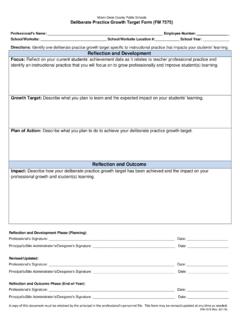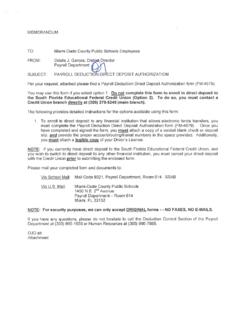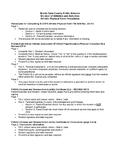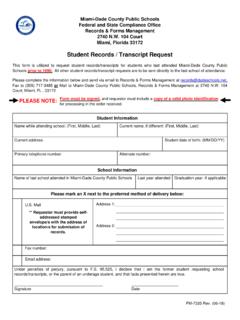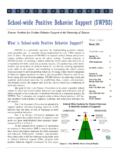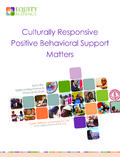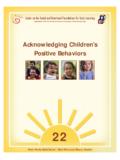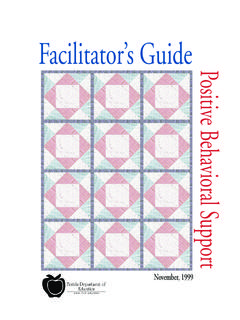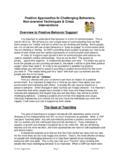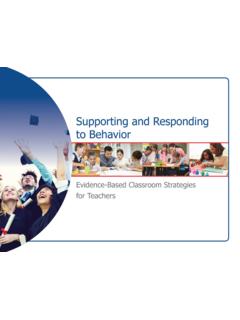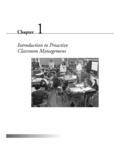Transcription of 6RFLDO (PRWLRQDO %HKDYLRU …
1 Student Name: _____ ID#: _____ DOB: _____ School: _____ Grade: _____ Date: _____ 1 Behavior Intervention Plan (BIP) Part 1 Problem Behavior Summary and Goal Statements Step 1: Problem Behavior Summary Statement: From the information provided from the Student Profile and considering all relevant data collected, identify ONE BEHAVIOR to be targeted for intervention. Write a brief summary statement that includes what set off the behavior, the behavior itself and what the student gains from the problem behavior. Setting Event Antecedent (A) Problem Behavior (B) Maintaining Consequence (C) The Function of the Behavior has been determined to be: Check one Step 2: Replacement Behavior: What behavior will the student perform in place of the problem behavior?
2 Complete the Goal Statement considering the above information Setting Event Antecedent (A) Replacement Behavior (RB) Reinforcing Consequence (C) 2..The student ..In order Especially 3. Especially 2..The student ..In order To Get To Avoid/Escape FM-6287 Rev. (04-12)Student Name: _____ ID#: _____ DOB: _____ School: _____ Grade: _____ Date: _____ 2 Behavior Intervention Plan Part 2 Problem Behavior: Definition of Problem Behavior: Explain in details below: Examples: using profanity around younger students Example: The use of language which is socially unacceptable for children to use around adults.
3 Replacement Behavior: Purpose(s) of Replacement Behavior: Example: Improve communication skills ask for help Example: To teach student to recognize anxiety or anger/frustration and get help to vent appropriately (cool down time, removing self from situation, speaking with staff/peers). Anticipated Behavior Changes include a description in measurable and observable terms of the behavior change(s) expected by those implementing the BIP Other: Example: Student will recognize when he is becoming angry and will seek the assistance of an adult rather than using profanity to gain attention FM-6287 Rev. (04-12)Student Name: _____ ID#: _____ DOB: _____ School: _____ Grade: _____ Date: _____ 3 Behavior Intervention Plan Part 3a Directions: Check one or two appropriate intervention(s) in each of the 3 categories.
4 Ensure that the chosen intervention(s) match the function of the problem behavior. Proactive Interventions Q What environmental adjustments and/or teacher behaviors will be attempted to make the problem behavior less likely to occur? P-1 Preferential seating P-2 Encourage positive peer connections P-3 Contract for grades P-4 Daily/Weekly progress report P-5 Establish teacher/parent communication system P-6 Frequent monitoring and redirection by teacher P-7 Establish a personal connection with student P-8 Choice making P-9 Curricular adjustments P-10 Encourage participation in extracurricular activities P-11 Provide guidance prior to independent work P-12 Follow-up to ensure student understanding of task/request P-13 Schedule adjustment P-14 Give student an
5 Opportunity to mentor/tutor a peer P-15 Increase frequency of task related recognition P-16 Allow student to use quiet time/space P-17 Identify appropriate settings for behavior(s) P-18 Visual schedule P-19 Environmental changes (lighting, furniture, sound sources) P-20 Other: A Consider adjustments to when and where the problem behavior is likely to occur; in addition, consider adjustments to subject/activity or the people present when the problem behavior is most likely to occur. Describe interventions in detail: FM-6287 Rev. (04-12)Student Name: _____ ID#: _____ DOB: _____ School: _____ Grade: _____ Date: _____ 4 Behavior Intervention Plan Part 3b Educative Interventions Q What new behaviors/strategies will be taught to replace the problematic behavior?
6 E-1 Teach rules/expectations prior to activity E-2 Have student repeat rules/expectations prior to transitions E-3 Develop monitoring checklist for teacher/student use E-4 Teach and model appropriate communication skills E-5 Provide opportunities to practice communication and social skills E-6 Teach coping skills (asking for time out, relaxation when frustrated) E-7 Teach positive self-talk E-8 Remediation in specific academic areas E-9 Perform Task Analysis: break down and concretize steps for success E-10 Use student's personal interests to increase motivation ( , If a student likes fishing, reading tasks can be related) E-11 Teach alternative behaviors for sensory feedback E-12 Teach anger management/problem-solving skills E-13 Teach behavioral self-control E-14 Social stories/Comic book conversations E-15 Other: Functional A What skills will the student need to be taught in order to successfully demonstrate the replacement behavior?
7 When? Who will teach? How will skills be taught/monitored across settings? Describe interventions in detail: FM-6287 Rev. (04-12)Student Name: _____ ID#: _____ DOB: _____ School: _____ Grade: _____ Date: _____ 5 Behavior Intervention Plan Part 3c Functional Interventions Q How will consequences be managed to ensure the student receives reinforcement for the replacement behavior? F-1 Use preferred activities as reinforcer F-2 Personally greet the student upon arrival to class F-3 Spend individual time with the student F-4 Increase frequency of positive reinforcement F-5 Use tangible and/or non-tangible rewards F-6 Develop a written behavior contract F-7 Assign classroom responsibility that allows student recognition F-8 Chart daily successes and review often with student F-9 Recognize small steps approximating the desired behavior F-10 Ignore undesirable behaviors F-11 Reward competing behaviors F-12 Student self-monitoring of progress F-13 Acknowledge use of replacement behaviors F-14 Establish logical
8 Sequences and inform students in advance F-15 Give encouragement for effort to display appropriate behavior F-16 Use of positive referrals F-17 Use classroom reinforcers for individual student accomplishments F-18 Call home to share news of student effort/success F-19 Use school-wide vehicles for recognition F-20 Other: A What will be done to increase the occurrence of the replacement behavior? Describe interventions in detail: FM-6287 Rev. (04-12)Student Name: _____ ID#: _____ DOB: _____ School: _____ Grade: _____ Date: _____ 6 Behavior Intervention Plan Part 4 Correction Procedures What will be done to decrease the occurrences of the problem behavior?
9 Choose all that apply. When the problem behavior occurs, the student will be verbally instructed to stop, and then will be redirected by: Utilizing precision requests/commands Provide verbal instruction Provide corrective feedback Other: _____ Minimal consequences/penalties will be used for the problem behavior as follows: Time owed Explain what student will be doing while paying this time Loss of incentive/privilege. Describe: _____ Positive practice. Describe: _____ Phone call to parent/guardian(s) Complete a behavior contract Implementation of a behavior management system Other: _____ FM-6287 Rev.
10 (04-12)Student Name: _____ ID#: _____ DOB: _____ School: _____ Grade: _____ Date: _____ 7 Behavior Intervention Plan Part 5 Crisis Management Plan (CMP) Directions: Please check ONE option and describe in detail. Please provide a detailed description of your crisis management procedures when the need for de-escalating student behavior is required. Please provide a detailed description of your crisis management procedures when the need for de-escalating student behavior is required for behaviors that may lead to the use of Physical Restraint Procedures. Physical Restraint Procedures may be used if student presents a danger to self and/or others.
